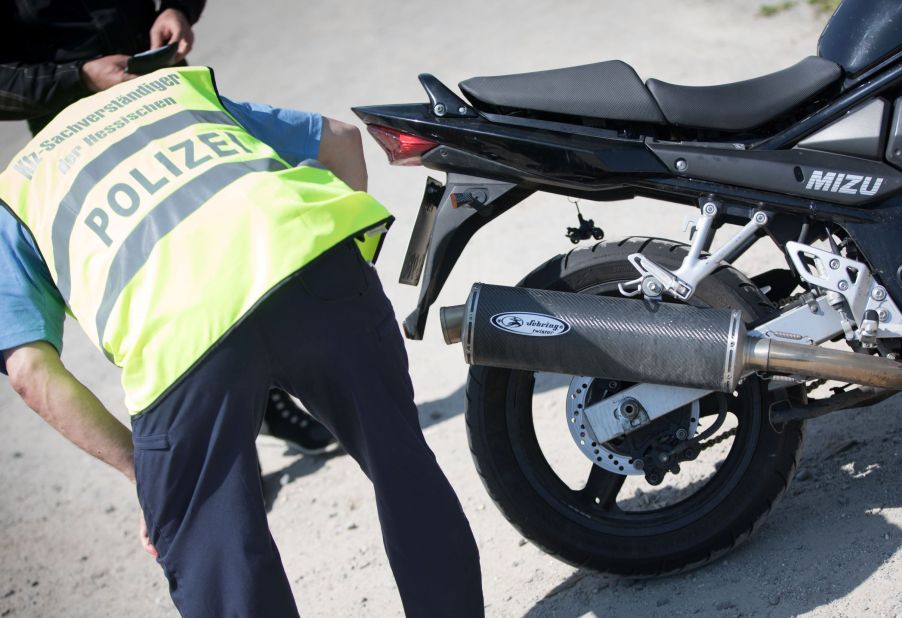
A New Study Confirms ‘Loud Pipes Save Lives’ Is a Safety Myth
Sometimes, it seems there are almost as many myths about motorcycle safety as there is genuine advice. And one that persists is the notion that ‘loud pipes save lives.’ I.e., the louder your motorcycle’s exhaust is, the safer you’ll be. But a new study has thoroughly debunked that.
A Romanian study spells it out: ‘loud pipes save lives’ doesn’t hold up

To be sure, a not-insignificant portion of ‘loud pipes save lives’ proponents are trying to justify their bike’s ear-splitting exhaust, RevZilla reports. Specifically, by claiming that by cranking up the volume, they’re letting other road-users—namely drivers—know their bikes are around. However, a recent study out of Romania has pounded the nail into that particular coffin.
This study was undertaken by the Romanian Association for the Development of Motorcycling, Autoweek reports, together with the Polytechnic University of Bucharest’s Department of Motor Vehicles. The goal was to see how loud a motorcycle’s pipes are for car passengers. A Netherlands-based specialist group, Enviro Consult, provided additional assistance.
In the study, six different bikes (unspecified) were revved to redline at various distances around a stationary car, MCN reports. Specifically, 50 feet behind the car, 33 feet behind the car, right next to the car, and right in front of it. Besides the motorcycle’s distances from the car, the study-runners varied the interior noise levels. The baseline was with the windows rolled up, RideApart reports, and the next step had the car’s engine gently revving and the radio playing.
The results, as you’ve likely gathered, are that loud pipes really don’t save lives. If the bike is 50 feet away, it can’t even be heard inside the car. And that’s even with the loudest motorcycle’s exhaust peaking at 110 dB. That’s chainsaw-level loud, the University of Michigan reports. Plus, even with the distance closed to 33 feet, only one bike was clearly heard inside of the car.
Once the motorcycles got right next to the car, the loud pipes were audible. But even then, only one bike—that 110-dB one—was heard over the ambient interior noise, Autoweek reports. The rest were barely detectable. And once the bikes got ahead of the car, the loud pipes made no difference.
Trying to make your bike’s exhaust louder could damage it and you
To be fair, there is a way for loud pipes to make themselves known even beyond 50 feet. But it would require a noise level above 135 dB, MCN reports. That’s louder than a jet plane taking off and too loud to ever pass any kind of road noise regulations. This brings up an excellent point about motorcycle exhaust modification, such as removing the muffler or fitting an aftermarket system.
Removing the muffler doesn’t increase your bike’s performance, Motorcyclist reports. Instead, it can damage the engine components. On the other hand, an aftermarket exhaust system, if installed correctly, can safely boost output, Cycle World reports. And often, doing so does make your motorcycle louder. However, that brings up another problem with fitting loud pipes: they can damage you.

Remember how one motorcycle in the Romanian study had a 110-dB exhaust? That’s loud enough to cause hearing damage in as little as 15 minutes of daily exposure, Motorcyclist reports. But it’s not just the engine’s fault. Above 25 mph, wind noise overtakes the noises your bike makes, RevZilla reports. And once you’re at highway speeds, that wind turns into a hearing-damaging gale.
That’s why a solid helmet and quality motorcycle armor aren’t the only pieces of safety gear you need. Invest in a good pair of earplugs, too, Motorcyclist reports. You can even get customized ones shaped to your ears; I did, and I use them all the time.
Instead of louder pipes, keep these motorcycle safety tips in mind before riding
In short, loud pipes don’t save lives. They really do the opposite. However, as we said earlier, there are genuinely helpful motorcycle safety tips out there. And they’ll serve you better than any exhaust pipe.
Motorcycle safety tip #1 is ‘ride like you’re invisible.’ Even modern ADAS features like blind-spot monitoring don’t prevent every accident. And with drivers depending on and overestimating their capabilities more and more, they may arguably be making things worse. So, assume no one sees you and look, think, and plan ahead accordingly, Motorcyclist explains. This matters especially at intersections, which are some of the most danger-prone spots on the road, RevZilla reports.
However, there are ways to increase your visibility to car drivers, Motorcyclist reports, which is motorcycle safety tip #2. Wear brighter colors, move (safely) within your lane, and stay out of driver blind spots. And if you’re allowed to lane-split, do so slowly and deliberately. That way, car drivers have a chance to see and mentally recognize your presence.
Finally, another important motorcycle safety tip is ‘wear your safety gear.’ That means, at a minimum, an armored jacket and pants, proper boots, a helmet, and quality gloves. Loud pipes won’t save your life, but real safety gear likely will.
Follow more updates from MotorBiscuit on our Facebook page.


